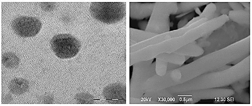Home > Press > Controlling Shape of Lead Nanoparticles by Sunlight: Indian researchers explore sunbeams as morphological changer of nanomaerials
 |
| TEM Image: Pb Nanospherical SEM Image: Rod Shape changed by Sunlight |
Abstract:
Indian researchers (Theivasanthi and Alagar) have controlled shape of lead nanoparticles by using sunbeams. They have explored sunbeams as morphological changer of nanomaerials The group, based at Centre for Research and Post Graduate Department of Physics, Ayya Nadar Janaki Ammal College comments: 典o our best knowledge, this is the first demonstration for controlling shape of lead nanopowder (Pb) under the influence of sunbeams.
Controlling Shape of Lead Nanoparticles by Sunlight: Indian researchers explore sunbeams as morphological changer of nanomaerials
India | Posted on April 11th, 2013The researchers have explained the detailed procedures in their recent report [Theivasanthi et al, nanobe.org/Pb nanorods ]. goo.gl/sIIuK . They have synthesized Pb spherical nanoparticles by electrolysis method using a bioactive compound - konjac (Amorphophallus Paeoniifolius) aqueous extract and such a procedure has so far not been used for nanoparticles preparation. This nanomaterial has potential applications in lead batteries, catalysis, superconductor and photonic crystal. TEM image confirms the 10 nm size of Pb nano-spherical.
In the report: Size and shape provides important control over many of the properties like physical, chemical and catalytic properties of nanomaterials. When nanomaterials interact with biological systems, their properties are changed significantly, may also be desirable characters in sometimes. While, on contact with a biological fluid they may become coated with proteins and other bio-molecules. Capping agents assisted synthesis methods usually produce spherical particles due to the low surface energy associated with such particles.
The researchers have said that generally, metal nanoparticles strongly absorb light in the visible region due to Surface Plasmon Resonance (SPR) and the absorbed light promotes some reactions on the nanoparticles. "On this basis, an attempt has been made to explore the effects of the sunlight on Pb nanoparticles and to find the possibilities for dual function utilization of sunlight i.e. as a dryer for the synthesized nanomaterials and as a morphological changer. The result explicates that it is possible to change the shape of Pb nanoparticles (konjac extract added) from spherical to rod by the influence of sunbeams", the researchers comment, adding: "Further research work is under process to find the possibility of morphological effect changes by sunlight, in other metal nanoparticles with konjac extract or other bio-molecules".
####
For more information, please click here
Contacts:
T.Theivasanthi
Copyright © Theivasanthi - Nano Researcher
If you have a comment, please Contact us.Issuers of news releases, not 7th Wave, Inc. or Nanotechnology Now, are solely responsible for the accuracy of the content.
| Related News Press |
News and information
![]() Researchers develop molecular qubits that communicate at telecom frequencies October 3rd, 2025
Researchers develop molecular qubits that communicate at telecom frequencies October 3rd, 2025
![]() Next-generation quantum communication October 3rd, 2025
Next-generation quantum communication October 3rd, 2025
![]() "Nanoreactor" cage uses visible light for catalytic and ultra-selective cross-cycloadditions October 3rd, 2025
"Nanoreactor" cage uses visible light for catalytic and ultra-selective cross-cycloadditions October 3rd, 2025
Discoveries
![]() Researchers develop molecular qubits that communicate at telecom frequencies October 3rd, 2025
Researchers develop molecular qubits that communicate at telecom frequencies October 3rd, 2025
![]() Next-generation quantum communication October 3rd, 2025
Next-generation quantum communication October 3rd, 2025
![]() "Nanoreactor" cage uses visible light for catalytic and ultra-selective cross-cycloadditions October 3rd, 2025
"Nanoreactor" cage uses visible light for catalytic and ultra-selective cross-cycloadditions October 3rd, 2025
Materials/Metamaterials/Magnetoresistance
![]() First real-time observation of two-dimensional melting process: Researchers at Mainz University unveil new insights into magnetic vortex structures August 8th, 2025
First real-time observation of two-dimensional melting process: Researchers at Mainz University unveil new insights into magnetic vortex structures August 8th, 2025
![]() Researchers unveil a groundbreaking clay-based solution to capture carbon dioxide and combat climate change June 6th, 2025
Researchers unveil a groundbreaking clay-based solution to capture carbon dioxide and combat climate change June 6th, 2025
![]() A 1960s idea inspires NBI researchers to study hitherto inaccessible quantum states June 6th, 2025
A 1960s idea inspires NBI researchers to study hitherto inaccessible quantum states June 6th, 2025
![]() Institute for Nanoscience hosts annual proposal planning meeting May 16th, 2025
Institute for Nanoscience hosts annual proposal planning meeting May 16th, 2025
Announcements
![]() Rice membrane extracts lithium from brines with greater speed, less waste October 3rd, 2025
Rice membrane extracts lithium from brines with greater speed, less waste October 3rd, 2025
![]() Researchers develop molecular qubits that communicate at telecom frequencies October 3rd, 2025
Researchers develop molecular qubits that communicate at telecom frequencies October 3rd, 2025
![]() Next-generation quantum communication October 3rd, 2025
Next-generation quantum communication October 3rd, 2025
![]() "Nanoreactor" cage uses visible light for catalytic and ultra-selective cross-cycloadditions October 3rd, 2025
"Nanoreactor" cage uses visible light for catalytic and ultra-selective cross-cycloadditions October 3rd, 2025
|
|
||
|
|
||
| The latest news from around the world, FREE | ||
|
|
||
|
|
||
| Premium Products | ||
|
|
||
|
Only the news you want to read!
Learn More |
||
|
|
||
|
Full-service, expert consulting
Learn More |
||
|
|
||








